
Topics Covered
Before we begin I want to make one thing clear:
Albino, true Albino of the red eyes, does NOT exist within the equine genome.
Equine Cream is very closely related, genetically speaking, to Human Albinism and there are mutations that dilute in such a way as to mimic Albinism in the horse, but There Are No True Albino Horses (Dominant White is not Albino, but we'll cover that later).
Basic Genetic Inheritance:
Every living being has two strands of DNA that combines to give us the traits we inherit from our parents and can pass to our offspring. We get one strand from mom and the other from dad; likewise our children will inherit one strand from us and one from our partner. There are mutations, of course, (like Downs Syndrome) where an extra strand or partial strand is passed, but we won't worry about that here.
With me so far? I'll give an example a little further down (or you can scroll ahead for a sneak peek), but we should probably touch on how the Game handles coat color inheritance.
When the game generates a horse it has two options: Blend the parents, if there are any, or pick something at random from it's memory. Wilds (assuming no Mods to the contrary) will generate from the second option. Bred horses will prefer to use a blend of parents, but every now and then the game will pull the Random Seed card; it does this to generate "genetic diversity". Interestingly, random mutations pop up all the time in real life (there's even a name for it: de novo mutation), just not in quite the same way they do in game.
If you breed your Sorrel stud and Buckskin mare you should see any number of colors ranging from Black to brown to palomino in their foals; at least you would if they were real horses. With game horses you will see a higher than average incidence of Red and Buckskin foals (and more than a few red foals with black manes or legs) and occasionally some odd color will pop up (like purple with polka dots, depending on any CC installed).
I used Cream in this example, and we'll cover that in Chapter 2, but I think you see what I mean. The kicker is that if you build the parents correctly then the foals should naturally inherit the layers (barring the Random Seed annoyance) to have a proper real world phenotype with little to no foal editing on your part. Proper building of the layers will be touched upon in each section, to try to keep it simple.
Extension: Black and Red
Every horse is one of two colors: Black or Red. Regardless of what it looks like, it's basic DNA will reveal one of these two. EVERY OTHER color appearance (called Phenotype) is a modification of one of these two Base Colors. These two colors are what the actual bottom layer of the Sims horse should be in CAP. Note that you may have to apply CC individually colorable hooves to a Red-based horse or a Black-based horse with an Ee genotype.
Extension (E) is the gene that controls the base color. If it is "on", or E, then the horse is Black; if off, or "e", then the horse is red. Extension is located at MC1R.
EE = Black, will never make a Red-based foal
Ee = Black, capable of making a Red-based foal
ee = Red
Sorrel, Chestnut, and Liver are terms used to describe the phenotype of a Red horse; genetically they are all identical (ee). As yet we do not know what mechanism causes the difference in shading, though some theorize that Agouti (Chapter 2) may play a part.


Say you have a mare that is Ee and you want to breed her. Depending on what the stallion's Extension factor is you could really get almost any color from her. Pairing her with an EE stud would guarantee a Black-based foal, for instance. An Ee stud would give 75% chance of Black and 25% chance of Red. An ee stud would give 50% Black and 50% red. Of course this is before adding in any other color or modifier.
Ee x ee

Extension Variances
The current Extension Factor test is more of a Red Test than a Black one in that it actually tests for the recessive Red allele (e) and reports the presence or absence of that mutation. Researchers have discovered a new mutation at e; it is notated as e superscript a, but as I can't reproduce that here I'll just leave it for now. This "New Red" returns a false Black on Extension tests (since it's technically not e). Some labs are able to provide an updated Extension Test to look for this new mutation. Breeds known to be affected are Black Forest Horse, some European Draft, and Spanish Ponies.
Note that many Black Forest Horse's are purported to be "Black Flaxens" while others are "Black Silver" or "Sorrel Silver" with a very dark coat and light mane and tail. Genetically some of these horses are Silver, which is not visible on a Red horse (and which we'll get to in Chapter 2), but others are actually Flaxen Chestnut with the New Red variant (thus "flax black" with a false positive on the Extension test) and a heavy dose of sooty (Flaxen and Sooty will be covered in Chapter 4).
Technical Stuff about MC1R Extension
The coloration controlled by MC1R is termed eumelanin (black) and phaeomelanin (orange-red). Dominant E "extends" the eumelanin, Recessive e blocks eumelanin (allowing for the expansion of phaeomelanin).
Grey
Grey does not hide. If a horse is a Grey you will see it. Grey overrides every color gene except white-spotting (Chapter 3). Grey is located at STX17.
Lippizan (as a breed) are Grey.
The American Albino (as a breed) is Cream and Cream Champagne.
The horses used in the prime-time TV drama Sleepy Hollow are White.
The horses used as Silver in the 2013 Lone Ranger Movie are White.
Grey is NOT Roan.
Grey is NOT White.
Grey is a dominant gene and requires that one parent be a Grey in order for the foal to be a Grey. Grey is progressive; the horse will lighten with age (if it lives long enough then it will eventually go all white).
During the greying-out process many horses go through an intermediate, "color blending", phase. On Red or Bay/Brown this shade is often called "Rose Grey"; over Black it is often termed "Steel Grey". Another intermediate stage is "Fleabitten". Characterized by assorted reddish brown spots scattered amongst the coat, it also includes the Bloody Shoulder characteristic desired by many Arabian breeders.
Of note is that Grey horses are more prone to developing melanoma's than their non-grey brethren. Homozygous Greys even more so.
Using the scheme illustrated above:
GG = Grey, will always have Grey foals
Gg = Grey, capable of making non-grey foals
gg = non-Grey
Grey horses will generally have "goggles" around their eyes, even as foals. These goggles are usually Light Grey over Black and Dark Grey over other colors.
A pair of Greys in game
The mare is a Seal Brown Base (Agouti, Chapter 2) and the filly is a Black base.
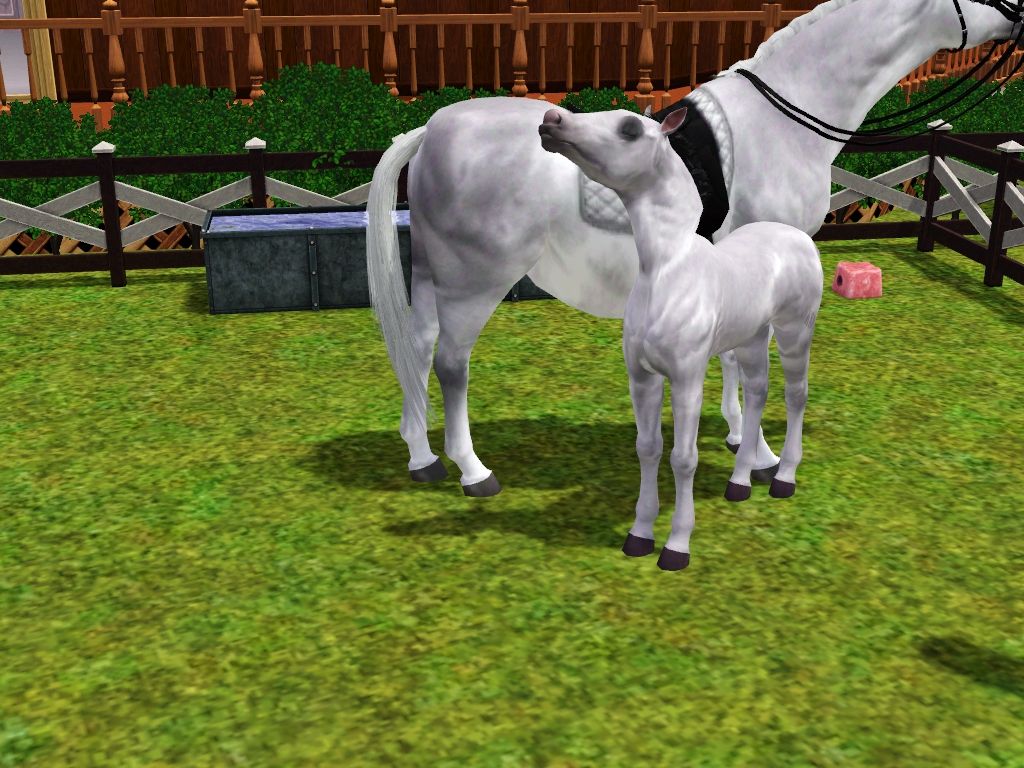

Winning Colors, Thoroughbred
Registered as a Roan, these pictures of her (in her youth at the Track and in retirement as an aged mare) clearly show she is a Grey.
It's a little tricky to spot, but you can see the light grey goggle on her right eye in the race photo.
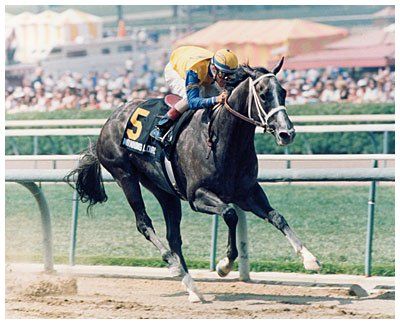
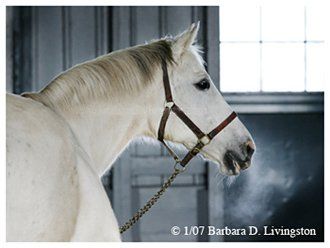
For Comparison: Patchen Beauty and The White Fox, Thoroughbred
Both of these horses are White, as in the Genetic mutation W2 "Dominant" White (Spotting gene, Chapter 3)
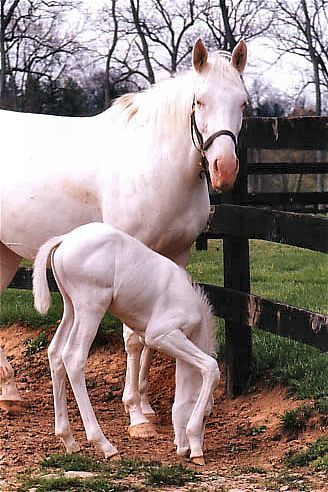
For Comparison: TCF Palladium, Thoroughbred
This horse is a Smoky Creme, or two Cream genes over Black (Cream, Chapter 2).
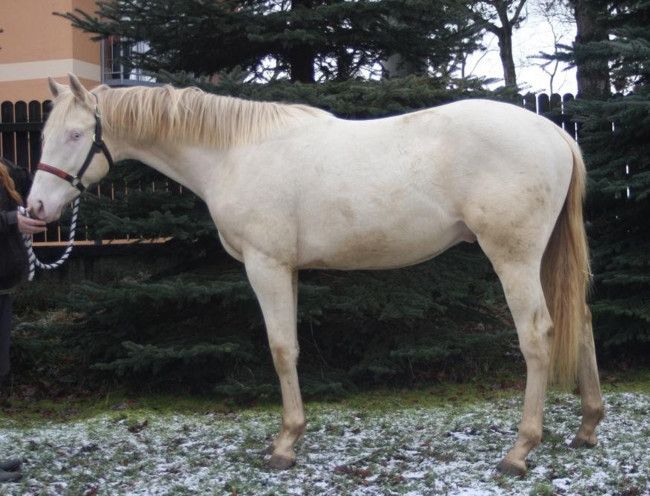
For Comparison: This game horse is Cremello (2 Cream over Red). She is also a Splash (Chapter 3).
The photobomb horse to the right is a Grey.

Grey Variant
Researchers are currently looking into what is being termed a "grey suppressor gene". What this gene does is take a horse that would otherwise express it's Grey gene and make it look like a Roan or Non-grey. There are entire families with this phenotype being studied; so far they are testing positive for the Grey gene, but they do not look at all like a typical grey.
Building the Sims horse (CAP)
In CAP you'll want to select the Advanced editor.
The bottom-most layer is the actual base layer. This layer should be Red or Black depending on if you want your horse to be able to make red foals or not.
Above this go all other layers; if you chose Red for the base of an Ee Black then add a Full Body layer and set it to Black.
If your horse has any of the white spotting genes they would layer next. Play around with the spotted and HD layers until it looks realistic. Sometimes they need to be resorted.
If you have the HD Coat make anther full coat layer and select the HD Coat. You can shade it Black (for non fading Blacks), Red (for Reds or fading Blacks), or a dark grey (for contrast). It can also be set to actually be Grey, set at partial opacity, and have the opacity increased as the horse ages to mimic the real world greying process for a Grey horse. This same layer can also be used to make Creams (yellow) or Champagnes (tan).
Shine layer will go on top; reuse one of the lower layer colors to make for realistic highlights and coat "bloom".
Tour the Farm
Circle F Main Office
Genetics Home
SIMply Equine (FB Group)